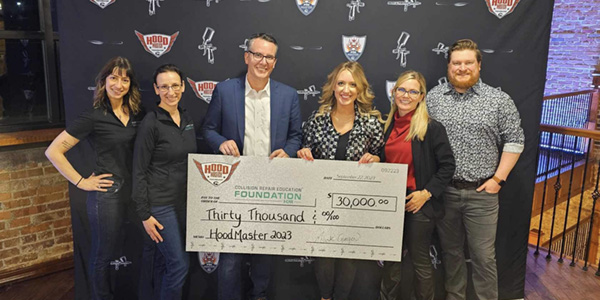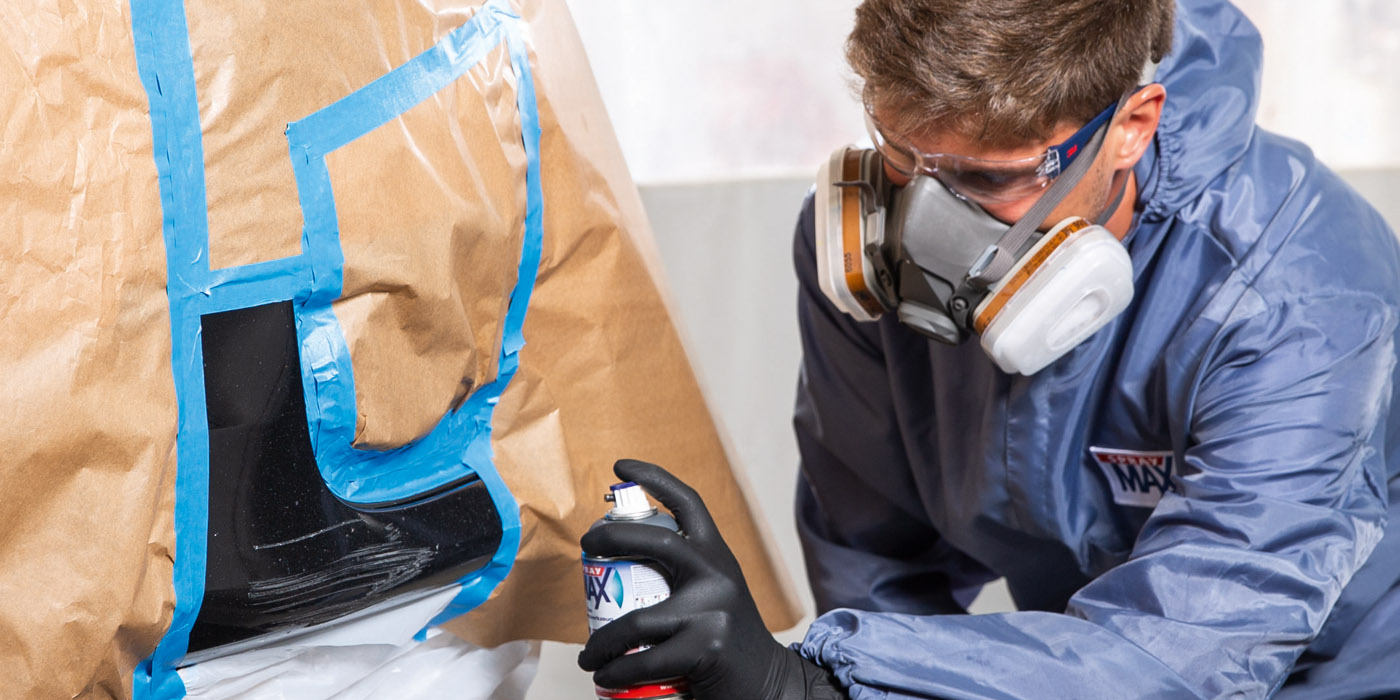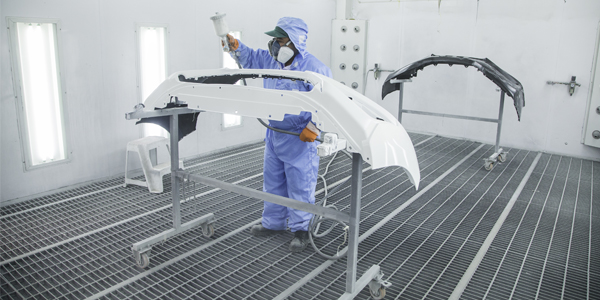Sometimes I look at my writer’s schedule and wonder where to begin. I know that my editor only assigns topics that you, our reader, are hungry to learn more about – fascinating topics that have a profound effect on our future happiness. Thus, we begin our in-depth look at the condition known to painters as solvent popping.
While researching this story, I went to the Internet and entered “Solvent Popping” in the Google search field. Two thousand eighty hits. What I found were references to solvent popping related to the painting of virtually anything you can imagine. The most repeated lines contained the words “paint film too high; flash times too short.” I don’t want to further complicate this issue, but I’ll tell you that paying attention to solvent speed, gun set-ups and flash times will keep you out of trouble.
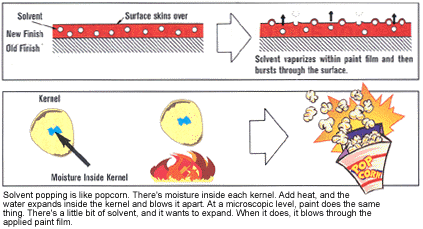
Also don’t confuse this with plain old blistering or, heavens, air entrapment. And don’t think for a minute that just because you suffer from dust contamination in your paint film that the academy of automotive paints and sciences is going to choose you as the winner tonight. No such luck. Solvent popping is my subject, and I’m sticking to it. In fact, the next time you encounter solvent popping, you’ll know enough about it to spin your boss’ ears off with your scientific explanation. He’ll have a newfound respect for your knowledge and scientific acumen. Just you wait and see.
Me & Three Chemists
I recently conducted interviews with three genuine paint company chemists: Kurt, Steve and Tom. They’re all full-time coatings-development people working for a major supplier of automotive OEM and refinish products. They were kind enough to take time from their busy schedules to share some insights into the problem of solvent popping and to offer solid advice to steer clear of this and other difficulties in your paint department.
You can be sure there are very few problems that painters in the field encounter that haven’t been dealt with in the laboratory. Every major paint company has an in-house testing department that uses tools and methods just like you have in your shop, and they couple that with a network of field reps and painters in shops all over the country. Once a product reaches the testing stages, it goes out to the field for evaluation, using a carefully controlled regimen. The feedback has to be genuine or it has no real value. It’s remarkable how much testing accompanies a new product introduction.
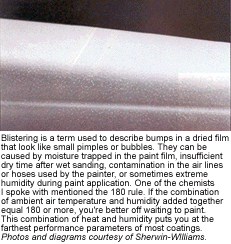
BSB: What’s actually happening when solvent popping occurs?
Tom: Solvent is coming out. You use solvent as a medium to transfer the paint to the part. That solvent needs to evaporate before the paint crosslinks or forms a continuous integrated film. That doesn’t happen when it pops. The top of the paint will crosslink and form a film with solvent underneath. Later that solvent will try to evaporate out – go from a liquid to a gaseous state – and that’s solvent pop. It’s like popcorn. There’s moisture inside each kernel. Add heat, and the water expands inside the kernel and blows it apart. At a microscopic level, the paint does the same thing. There’s a little bit of solvent, and it wants to expand. When it does, it blows through the applied paint film.
BSB: What’s the gas? Is it air?
Tom: No. It’s solvent changing from a liquid to a gaseous state.
Steve: It’s solvent evaporating – just like it normally would – except now it has to evaporate through something: the previously applied film.
BSB: Is that outgassing a flammable byproduct?
Tom: Yes. Some solvents are very slow. They’d really be called combustible on a DOT scale.
Steve: The stuff coming out is the same stuff you mixed in the paint. It’s not a gas. It’s just the solvent.
Kurt: It’s trapped. It’s like a sphere. You can actually see them imbedded as you go down through the dry paint film – particularly on clearcoat. Because they reach different levels in the dry paint film, they’re not buffable. You can sand them, but you’re left with a pinholing issue.
Tom: You’re actually seeing the top of the sphere we spoke of. As you sand, you get into the body of the sphere, and the hole will actually get larger. By that time, you should remove all of the affected product from the vehicle.
BSB: So on the great scale of problems, this is a bad one. No quick fix. You must remove and refinish.
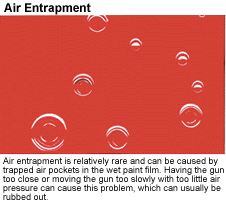
BSB: What causes solvent popping? Is it the gun? The painter? Film build?
Tom: Yes! I’d also add solvent choice to the list, very close to film build.
BSB: So we’ve got a new booth and a professional painter who’s well-trained but applies too much film build and it’s jackpot?
Kurt: The solvent choice is related to that. If you choose too fast a solvent, you’re in trouble.
BSB: In the field, do you see these problems when shops get new equipment?
Tom: Yes. And it’s not that they do everything wrong. Often they just do it the old way – and that will no longer work. And generally in spring and fall, we see more situations develop because of atmospheric changes.
Steve: When the painter doesn’t adjust his solvent use for the change in climate, usually in the fall things dry too slowly and in the spring is when we see solvent popping.
BSB: And the boss is telling the painters, “Don’t buy any more solvent till you use this up!”
Kurt: Which only prolongs the problem.
Tom: You need to understand that there’s a variety of solvents in every paint product. What that means is that there’s a variety of evaporation rates in the solvents used to manufacture paint products. So if the painter adds a fast reducer, that doesn’t mean that all the solvent in that paint would be what you’d consider fast evaporating. There also will be some slow solvent in there.
As the temperature increases, if you continue to add the fast solvent, the top of the paint will form a film, or skin over. There’s still solvent in the paint that’s slow evaporating (tail solvents). So it’s getting warmer out, you’re still using the fast-dry solvent and there’s less solvent getting to the part because it’s evaporating en route. But the solvent that’s getting to the part is the slow, tail solvent, so now the paint is setting up, the top is skimming over and these tail solvents need to get out. As the part warms up and as the material cures and shrinks, that solvent will wind its way upward. If it can’t get out as normal evaporation, it will bust its way out.
The thicker the film build, the more solvent you’ve put there and the longer it’ll take for all that solvent to get out. At the same time, you’re crosslinking at the same speed you would for a thin film or you’re doing things that make the paint dry on the top, like using the wrong solvent. These are the two largest causes of solvent popping. You can also get into other things like atomization, the gun, airflow in the booth.
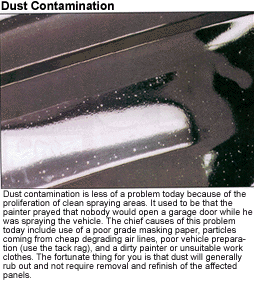
BSB: So as paint chemists, you’re engineering the product in the can to reach the correct flow without the painter having to knock himself out?
Tom, Steve, Kurt: YES! If the painter has to do things to adjust for poor chemistry, he’s in trouble. We need to put the best product possible in the can.
BSB: In our automotive business, we talk about a single wet coat, a full wet coat, a flowing wet coat and one to two double wet coats. Industrially, and when I sell to fleet users, I take a wet film gauge and spray some product out on a test panel, and the painter drags the film gauge and knows just what to do. Is it time for our industry to establish a benchmark? This is what a single wet coat is? Do we need that in the automotive refinish business?
Tom: That would be fantastic – if we could control all the painters with all the different guns.
Steve: That would take all the fun away from the marketing guys.
Kurt: Any time we can be more precise, we all win. Our tech reps play an important part and will work with painters to clarify instructions. They’ve been shown exactly what we mean.
Steve: Sometimes products get introduced as a marketing concept in combination with technology, touting productivity improvements. Look at a one-coat clear for example. If you read the fine print, some companies said to throw on a dust coat, move up two panels and come back to apply a full wet coat. But you’ve got to formulate the accelerator package and the solvent package in order to do that. A lot of clears could probably do that if we tailored the ingredients. But it may or may not be an advantage. If everything isn’t perfect, you could have popping and slow problems like you’ve never imagined.
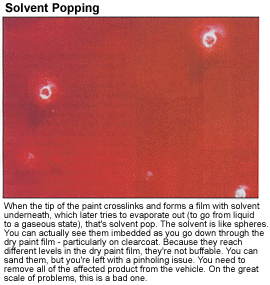
BSB: When you say solvent package, you mean the solvents you manufacture the product with in combination with the solvents that the technician will add at point of use?
Steve: Yes, the whole solvent package.
Tom: As chemists when we talk about a clearcoat, we mean ready-to-spray. All the parts and pieces. We package it and have tested it to be used in a wide variety of conditions. We know that if you put this, this and that together, it works.
Steve: The good painter has a knack for reading the instructions and making sound decisions based on the needs of the vehicle and on the climate he’s working in.
Kurt: And that’s the professional we all work for.
BSB: When the new generation of spraybooths began to show up in the American market back in the ’80s, the timers were programmed to have a purge cycle between painting and baking. Now we go right from paint to bake. What changed?
Kurt: It used to be that we’d apply single coats of product at a time and recommend flash times between every coat. The paint temp air can actually skin the surface and cause problems. The heat melts the resin and starts the crosslink.
Steve: The change required a real resin reformulation. You couldn’t just take standard acrylic 20 years ago and formulate it to do what today’s clears will do. These properties get built into the resin. When we balance and make a well-formulated product and add the right solvent, we can march right past flash times. This is all driven by the need for productivity. How many cars can we get through that booth. Where can we save time? We’ve pulled time out of the refinish process.
BSB: I recall hearing painters say, “The car was perfect last night and when I came in here this morning, the hood, roof and deck were bubbled over.” Is this still happening?
Kurt: A lot less. It was common when we had soluble substrates, like lacquer primer and sealers.
Steve: I’ve only seen this where there is super high humidity, like down South in August.
Tom: It’s the worst of all possible worlds scenario. You have to do the two bad things. You have to put in oh-so-slow solvents because it’s hot, and then the humidity is so high that they’re even slower and won’t come out. At the same time, you have heat that’s speeding up the crosslinking reaction. At this point, it helps to be lucky.
I found it refreshing and encouraging to hear the people who invent the products we use interested in what the customer needs, as well as what painters need to know. Painters tell us that they sometimes wonder if anyone at the paint companies is listening. I can say for sure that there are concerned folks at every step of the food chain. If you have questions and concerns and don’t believe you’re getting straight answers, call somebody else.
Also keep track of what you do in your paint department. Make sure that solvents and hardeners fit the climatic conditions in your area. Read the technical data sheets that accompany your products, and ask if there’s something you don’t understand.
And be glad you’re not painting canvas canoes. In the “Close to the Land” article by Clayton White (on Google), he offers the following advice: Wait three or four weeks for the oil-based paint to dry, and this will ensure maximum hardness and prevent solvent popping.
Writer Michael Regan is president of The J.J.R. Company in Cleveland, Ohio, and a contributing editor to BodyShop Business.










